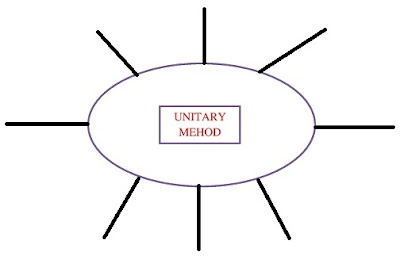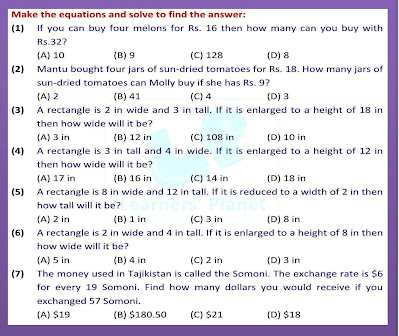LESSON PLAN OF UNITARY METHOD
LESSON PLANNING OF UNITARY METHOD
Subject Mathematics
Grade 5th
Students` Learning Outcomes
- Describe the concept of unitary method.
- Calculate the value of many objects of the same kind when the value of one of these objects is given.
- Calculate the value of a number of same types of objects when the value of another of the same type is given (unitary method)
Information for Teachers
- In unitary method we deal with the following:
o Finding the price of more things when price of one thing is given.
o Finding the price of 1 thing if price of more things is given.
o Finding the price of given number of things if the price of other number of same things is given.
- During lesson where necessary also consult textbook.
Material / Resources
Writing board, chalk / marker, duster,
prepare question slips for application of unitary method, chart paper
Introduction
- Announce that today we will explore about unitary method.
Development
Activity 1
- Write “Unitary method” in the middle of the board.
- Ask the class what do they know about Unitary Method?
- Write their responses on board, appreciate closer or correct answers.
- In the word unitary encircle unit and say that unit means one.
- If we know the relation of one unit value with more values we can find the relation of any value with any other numbers. Write the question on the board “If 1 dollar is equal to Rs. 184” then what is the value of 10 dollars?
- Let them think and come up with the answer 184 x 10 =1840.
- Tell them that as we got the value of one dollar we were able to find the value of 10 dollars.
- Tell the students that in the same way if we are given value of certain objects / things we can find the value of other number or quantity of the same object / thing.
- Tell the students like a story;
- Ask students:
How many bananas I bought? [30]
How much I paid for that? [Rs. 150]
- To pay for 20 bananas what do I need to know? [Rate or cost of 1 banana]
- How would I know the rate of the bananas? [By using unitary method]
- Ask students following questions and tell them to tell you what they need to get the answer.
- Appreciate the correct work and encourage students to give more examples of the same kind.
- Select few questions from the textbook exercise and give as individual work to do in their notebooks. Activity 2
- Ask volunteer students to explain in their own words telling how unitary method is used to solve the following questions;
- Ask similar type of questions to reinforce that it`s easy to find the value of one object is given.
- After students explain the questions refer them in pairs to the textbook selected questions to solve in their notebooks.
- Keep roaming in the class while students are doing their work. Correct them if they make any mistake.
Activity 3
- Divide the class into groups of 4 or 5.
- Select one group leader and assign him / her to explain unitary method to each of your group member. (Allocate 7 minutes)
- Working in the same groups, develop 5 questions which can be solved with unitary method.
- Prepare questions slips; also ask them to write their group number at the back of their sheets.
- Ask each group to take slips according to the members of the group.
- Read the statements and identify wrong statements.
- Solve the correct questions.
- Paste the slips on a chart paper and display in classroom.
- Turn by turn call groups and ask them to explain the work.
- Appreciate for correct work and make corrections in wrong answers and questions.
Sum up / Conclusion
- Lesson will be concluded by recapping following points;
- How to find unit cost if cost of more items is given?
- What will you do if you are given the cost of 15 items and you have to find the cost of one item?
- State the operation done if you are given the cost of 15 items and you have to find the cost of 18 items?
- What is the use of unitary method in daily life?
Assessment
- Call three students on the board and give them names of alphabets “A, B and C”. tell them to remember their names.
- Allocate time 5 minutes.
- Attempt following questions according to their alphabet.
Follow up
- Assign practice questions from the textbook.
- Ask them to create two story problems to be
shared in the next class in which unitary method is to be applied.













Nice
ReplyDelete